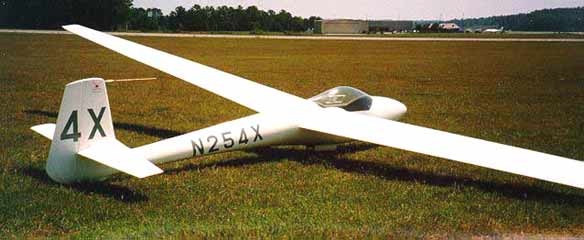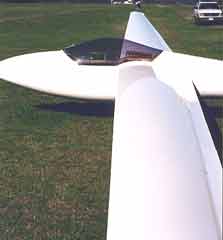Libelle Sailplane
As its name implies, the Standard Libelle is a version of the popular Open Class H 301 Libelle with modifications to meet the Standard Class requirements; these consisted of removing the flaps and tail braking parachute, fitting a fixed instead of retractable mono wheel and raising the height of the canopy. A new Wortmann wing section was featured and terminal velocity dive brakes were fitted. The canopy is unusual in having a catch that enables the front to be raised by 25mm in flight to provide a blast of ventilating air if required, instead of the more conventional small sliding panel used for this purpose. When the Standard Class rules were modified in 1970, a retractable mono wheel was substituted for the fixed one. The Standard Libelle is of similar glass fiber construction to the H 301 Libelle, and likewise has provision for 30 lbs of water ballast in the wing leading edge.
The prototype made its first flight in October 1967 and the Standard Libelle proved to be very popular, a total of 601 being built altogether. The type soon made its mark in contest flying; one flown by Per-Axel Persson of Sweden, winner of the 1948 World Championships, came second in the Standard Class at the 1968 World Championships at Leszno in Poland.
 The
H 101 Salto is a version of the Standard Libelle developed by
Frau Ursula Hänle, widow of Ing Eugen Hänle, the former
Director of Glasflügel; the Salto (German for loop) is produced
by Start + Flug GmbH formed by Frau Hänle, and differs from
the Standard Libelle largely in having a V-tail with an included
angle of 99°. The Salte also owes something to the V-tailed
Hütter H-30 GFK. Four flush-fitting air brakes repositioned
on the wing trailing edges replace the more conventionally-located
air brakes of the Standard Libelle; the Salto's air brakes are
hinged at their mid-points so that half the surface projects above
the wing and half below.
The
H 101 Salto is a version of the Standard Libelle developed by
Frau Ursula Hänle, widow of Ing Eugen Hänle, the former
Director of Glasflügel; the Salto (German for loop) is produced
by Start + Flug GmbH formed by Frau Hänle, and differs from
the Standard Libelle largely in having a V-tail with an included
angle of 99°. The Salte also owes something to the V-tailed
Hütter H-30 GFK. Four flush-fitting air brakes repositioned
on the wing trailing edges replace the more conventionally-located
air brakes of the Standard Libelle; the Salto's air brakes are
hinged at their mid-points so that half the surface projects above
the wing and half below.
The Salto prototype first flew in March 1970 and 60 had been delivered by the spring of 1977; German type certification was granted on 28 April 1972 and the Salto has also been certificated by the FAA as well as Germany in the Normal and Aerobatic categories. The wing span is 44ft 7 1/2in but a 49ft 2 1/2in span wing can be fitted optionally for Normal category operation; the former wing has an area of 92.35sq ft and an aspect ratio of 21.8. The landing gear consists of a fixed mono wheel with a fairing and a tailskid, and the one-piece canopy is hinged to open sideways.
 The
Libelle first flew in 1964 and quickly revolutionized competitive
soaring. It spearheaded the fiberglass take-over in American competition
flying, becoming the first fiberglass sailplane to receive an
U.S. ATC. In 1969 Soaring magazine readers voted the Libelle the
World's most beautiful sailplane and the one they would most like
to own. The H 301 Libelle has camber-changing flaps and was able
to compete both in the Open Class and, with locked flaps, in the
Standard Class.
The
Libelle first flew in 1964 and quickly revolutionized competitive
soaring. It spearheaded the fiberglass take-over in American competition
flying, becoming the first fiberglass sailplane to receive an
U.S. ATC. In 1969 Soaring magazine readers voted the Libelle the
World's most beautiful sailplane and the one they would most like
to own. The H 301 Libelle has camber-changing flaps and was able
to compete both in the Open Class and, with locked flaps, in the
Standard Class.
The first fiberglass glider to come to the US
in large numbers was the Glasflügel H 301 Libelle. It revolutionized
soaring. The fiberglass wing was so smooth that it was possible
to achieve and consistently maintain large "runs" of
laminar flow on the wing. This resulted in lower drag, and higher
all around performance on an easily maintained production glider. It
is still amazing to see the many advanced features present in
this very early fiberglass glider. Flaps, ailerons that interconnected
with the flaps, automatic hook ups for the flaps and spoilers,
water ballast- the list goes on.
Glasflügel means "glass wing" and "Libelle"
means dragonfly. The intent, so far as I can tell from looking
at the distinctive logo, was to link the idea of transparent wing
of the insect with the then-novel fiberglass construction method.
The 301 has down turned wing tips, flaps,
airfoil, and a high aspect ratio wing plan form, and
a balsa core in the wing skin. Virtually all 301s now fly with
the high profile style canopy. There was a low profile racing
canopy, but it reduced pilot head room, and the benefit was not
all that great. It was dropped when the later models came along.
The second model of the Libelle to come along was the 201. (Strange
that 201 comes after 301, but that is how it happened.) The rules
for the racing "Standard Class" changed to disallow
flaps, so a new wing was built for the 301 fuselage that had a
different airfoil, a little more area, no flaps, upturned wing
tips etc.
Specifications: |
 |







